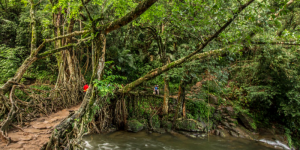
‘Jingkieng Jri or Living Root Bridge’, found in over 70 villages in Meghalaya highlighting the socio-cultural, social and botanical links between people and nature, has been included in the tentative list of World Heritage Sites of the United Nations Educational, Scientific and Cultural Organisation (UNESCO).
Buy Prime Test Series for all Banking, SSC, Insurance & other exams
Villagers grow the living root bridges by training the ‘ficus elastica’ tree on both sides of water bodies over a period of about 10 to 15 years where the roots form the bridge. At present, there are about 100 known living root bridges spread across 72 villages in the state. Villagers, (especially Khasi and Jaintia tribal communities) build and maintain these bridges from the past for more than 600 years.
Other sites included in the list:
The Geoglyphs of the Konkan region of Maharashtra, Sri Veerabhadra Temple and Monolithic Bull (Nandi) at Lepakshi of Andhra Pradesh have made it to the Tentative list of UNESCO world heritage sites in 2022.
Important takeaways for all competitive exams:
- UNESCO Founded: 16 November 1945
- UNESCO Headquarters: Paris, France
- UNESCO Members: 193 countries
- UNESCO Head: Audrey Azoulay
Find More Miscellaneous News Here




 World Basketball Day 2025 Celebrates Bas...
World Basketball Day 2025 Celebrates Bas...
 UN Celebrates Second World Meditation Da...
UN Celebrates Second World Meditation Da...
 Winter Solstice 2025 Observed on Sunday,...
Winter Solstice 2025 Observed on Sunday,...







